Aims and Objectives of Employment Regulation
29 Pages7965 Words1 Views
Added on 2022-12-30
About This Document
This document provides an overview of the aims and objectives of employment regulation, including fairness, compliance with international obligations, and protection of employees. It explains the role of tribunal and courts in enforcing employment law and how cases can be settled before or during legal procedures. The document also identifies the main principles of discrimination law during recruitment, selection, and employment. Additionally, it explores contract law and explains how contracts of employment are established. Lastly, it describes when and how contracts can be changed lawfully.
Aims and Objectives of Employment Regulation
Added on 2022-12-30
ShareRelated Documents
5EML
Unit: 5EML
Unit: 5EML

Table of Contents
Legal System...................................................................................................................................4
1. Explain the aims and objectives of employment regulation.....................................................4
Fairness........................................................................................................................................4
Compliance with international obligations..................................................................................4
Protection of employees..............................................................................................................5
2. Describe the role played by the tribunal and courts system in enforcing employment law.....5
3. Explain how cases can be settled before or during formal legal procedures...........................7
Arbitration....................................................................................................................................7
Mediation.....................................................................................................................................7
Conciliation..................................................................................................................................8
Avoiding Discrimination.................................................................................................................8
4. Identify the main principles of discrimination law during recruitment, selection and
employment.....................................................................................................................................8
Contract Law...................................................................................................................................9
5. Explain how contracts of employment are established............................................................9
Offer.............................................................................................................................................9
Acceptance.................................................................................................................................10
Consideration.............................................................................................................................10
Intentions...................................................................................................................................10
6. Describe when and how contracts can be changed lawfully..................................................11
Organisational change...................................................................................................................12
7. Explain the main requirements of redundancy law...................................................................12
8. Explain the main requirements of the law on business transfers...............................................13
1
Legal System...................................................................................................................................4
1. Explain the aims and objectives of employment regulation.....................................................4
Fairness........................................................................................................................................4
Compliance with international obligations..................................................................................4
Protection of employees..............................................................................................................5
2. Describe the role played by the tribunal and courts system in enforcing employment law.....5
3. Explain how cases can be settled before or during formal legal procedures...........................7
Arbitration....................................................................................................................................7
Mediation.....................................................................................................................................7
Conciliation..................................................................................................................................8
Avoiding Discrimination.................................................................................................................8
4. Identify the main principles of discrimination law during recruitment, selection and
employment.....................................................................................................................................8
Contract Law...................................................................................................................................9
5. Explain how contracts of employment are established............................................................9
Offer.............................................................................................................................................9
Acceptance.................................................................................................................................10
Consideration.............................................................................................................................10
Intentions...................................................................................................................................10
6. Describe when and how contracts can be changed lawfully..................................................11
Organisational change...................................................................................................................12
7. Explain the main requirements of redundancy law...................................................................12
8. Explain the main requirements of the law on business transfers...............................................13
1
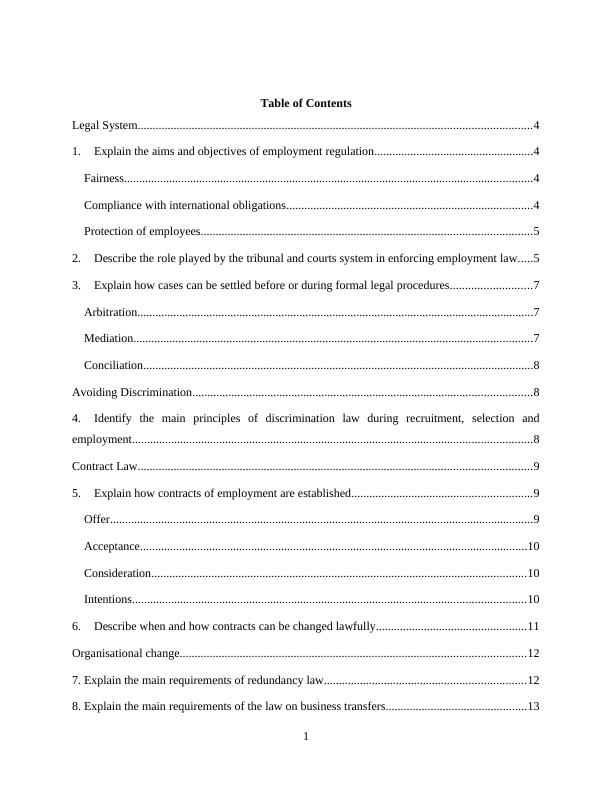
Workers’ rights..............................................................................................................................14
9. Identify the major statutory rights workers have in the fields of pay, leave and working time 14
Working time.............................................................................................................................14
Leaves........................................................................................................................................15
Pay.............................................................................................................................................15
10. Explain the major requirements of equal pay law...................................................................15
11. Explain major maternity, paternity and other family-friendly employment rights.................16
12. Identify the major requirements of health and safety law.......................................................17
13. Explain the significance of implied duties as regards the management of employees at work
.......................................................................................................................................................18
14. Explain the principles of the law on freedom of association...................................................19
Dismissal........................................................................................................................................20
15. Explain the main requirements of unfair dismissal law in respect of capability and
misconduct issues..........................................................................................................................20
16. Explain the scope of the right for employees to be accompanied at serious discipline and
grievance hearings.........................................................................................................................21
References......................................................................................................................................23
2
9. Identify the major statutory rights workers have in the fields of pay, leave and working time 14
Working time.............................................................................................................................14
Leaves........................................................................................................................................15
Pay.............................................................................................................................................15
10. Explain the major requirements of equal pay law...................................................................15
11. Explain major maternity, paternity and other family-friendly employment rights.................16
12. Identify the major requirements of health and safety law.......................................................17
13. Explain the significance of implied duties as regards the management of employees at work
.......................................................................................................................................................18
14. Explain the principles of the law on freedom of association...................................................19
Dismissal........................................................................................................................................20
15. Explain the main requirements of unfair dismissal law in respect of capability and
misconduct issues..........................................................................................................................20
16. Explain the scope of the right for employees to be accompanied at serious discipline and
grievance hearings.........................................................................................................................21
References......................................................................................................................................23
2
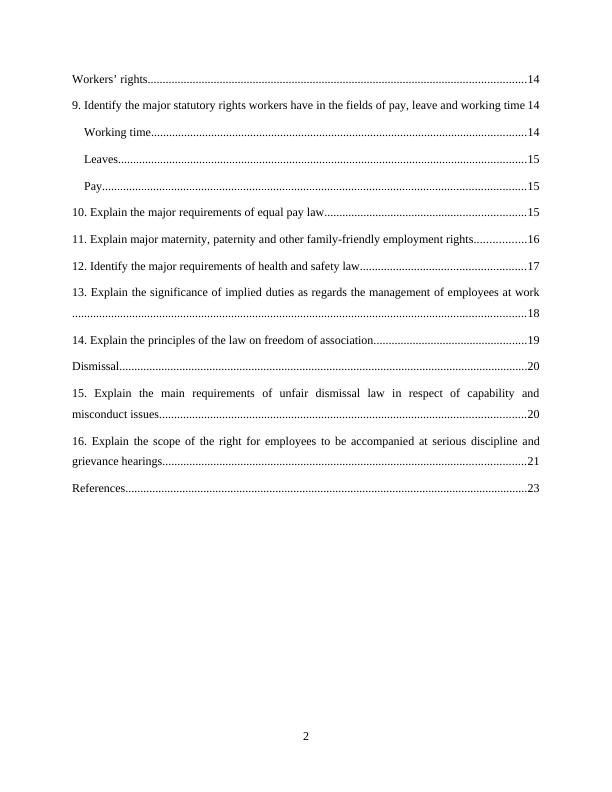
Legal System
1.1 Explain the aims and objectives of employment regulation
Fairness
The aim of employment regulation is to ensure fairness and equality across the organisations.
The reason for enacting different regulations in employment law is to provide blueprint guidance
to employers regarding following fair procedures in their conduct towards employees (Ebzeeva,
2020). For instance, the employment regulations determine the fair policies regarding
compensation and minimum wage rates. These regulations also direct employers to provide
equal employment opportunities to everyone regardless of their age, gender, sexuality, race,
colour and faith etc. Thus, these regulations determine a benchmark which organisations must
follow to become fair and just (Plickert and Sterling, 2017). The regulations ensure fairness in
recruitment, rewards, employment opportunities and conflict resolution.
Compliance with international obligations
The national or UK employment regulation are also levied and formulated in due compliance
with international laws i.e. EU obligations. The international labour standards act as a
preliminary tool for policy and lawmakers to draft laws that are in line with international
obligations (Blessing, 2014). For instance, the Human Rights Convention and employment law
of the EU guide the UK law. The employee safety, anti-child labour regulations, provision of
health benefits, protecting human rights of employees are some of the international standards
with which the UK must conform to. Thus, one of the objectives of employment law is to
comply with international labour standards relating to workplace and employer-employee
relations (Ebzeeva, 2020).
3
1.1 Explain the aims and objectives of employment regulation
Fairness
The aim of employment regulation is to ensure fairness and equality across the organisations.
The reason for enacting different regulations in employment law is to provide blueprint guidance
to employers regarding following fair procedures in their conduct towards employees (Ebzeeva,
2020). For instance, the employment regulations determine the fair policies regarding
compensation and minimum wage rates. These regulations also direct employers to provide
equal employment opportunities to everyone regardless of their age, gender, sexuality, race,
colour and faith etc. Thus, these regulations determine a benchmark which organisations must
follow to become fair and just (Plickert and Sterling, 2017). The regulations ensure fairness in
recruitment, rewards, employment opportunities and conflict resolution.
Compliance with international obligations
The national or UK employment regulation are also levied and formulated in due compliance
with international laws i.e. EU obligations. The international labour standards act as a
preliminary tool for policy and lawmakers to draft laws that are in line with international
obligations (Blessing, 2014). For instance, the Human Rights Convention and employment law
of the EU guide the UK law. The employee safety, anti-child labour regulations, provision of
health benefits, protecting human rights of employees are some of the international standards
with which the UK must conform to. Thus, one of the objectives of employment law is to
comply with international labour standards relating to workplace and employer-employee
relations (Ebzeeva, 2020).
3
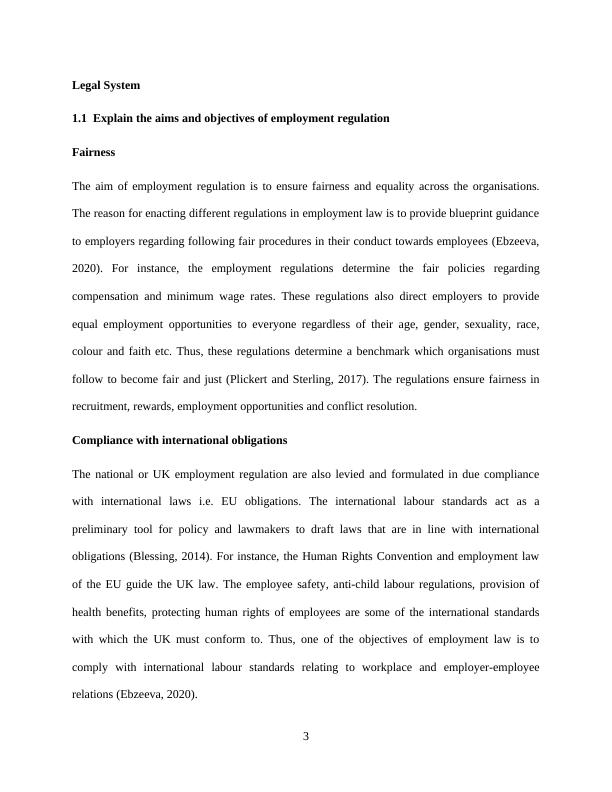
Protection of employees
Primarily, laws are enacted to ensure order in society and prevent any criminal activities that
violate human rights. Similarly, the purpose of employment law and regulation is to protect
employees’ freedom and rights. The employment laws contain regulations and legislation that
address the rights of employees such as the equitable salary, minimum wage, right to paid leaves,
maternity leaves, notice before termination, provision of a healthy and safe work environment
etc. Several legislations have been devised in this regard such as the 1998 Act of National
Minimum Wage, 1996 Act of Employment Rights etc. (Subramanian and Megginson, 2012).
1.2 Describe the role played by the tribunal and courts system in enforcing employment
law
Employment tribunals play an instrumental role in resolving employment conflicts in a quick,
informal, and cost-effective manner. Employment tribunals handle the claims and disputes
between employees and employers. The employee may claim unfair treatment or dismissal,
discrimination, wage deduction or unequal pay (Brill, 2018). Many employees prefer being
represented in tribunals. The process of the employment tribunal is as follows:
Before making a claim, the claimant engages with ACAS for early conciliation process for
settlement for a month
Claimant fills the form if conciliation is not achieved and it is sent to the respondent
The respondent fills the response form within 28 days
The tribunal may reject a claim if the information is not complete or the form is not sensibly
drafted to be responded
4
Primarily, laws are enacted to ensure order in society and prevent any criminal activities that
violate human rights. Similarly, the purpose of employment law and regulation is to protect
employees’ freedom and rights. The employment laws contain regulations and legislation that
address the rights of employees such as the equitable salary, minimum wage, right to paid leaves,
maternity leaves, notice before termination, provision of a healthy and safe work environment
etc. Several legislations have been devised in this regard such as the 1998 Act of National
Minimum Wage, 1996 Act of Employment Rights etc. (Subramanian and Megginson, 2012).
1.2 Describe the role played by the tribunal and courts system in enforcing employment
law
Employment tribunals play an instrumental role in resolving employment conflicts in a quick,
informal, and cost-effective manner. Employment tribunals handle the claims and disputes
between employees and employers. The employee may claim unfair treatment or dismissal,
discrimination, wage deduction or unequal pay (Brill, 2018). Many employees prefer being
represented in tribunals. The process of the employment tribunal is as follows:
Before making a claim, the claimant engages with ACAS for early conciliation process for
settlement for a month
Claimant fills the form if conciliation is not achieved and it is sent to the respondent
The respondent fills the response form within 28 days
The tribunal may reject a claim if the information is not complete or the form is not sensibly
drafted to be responded
4
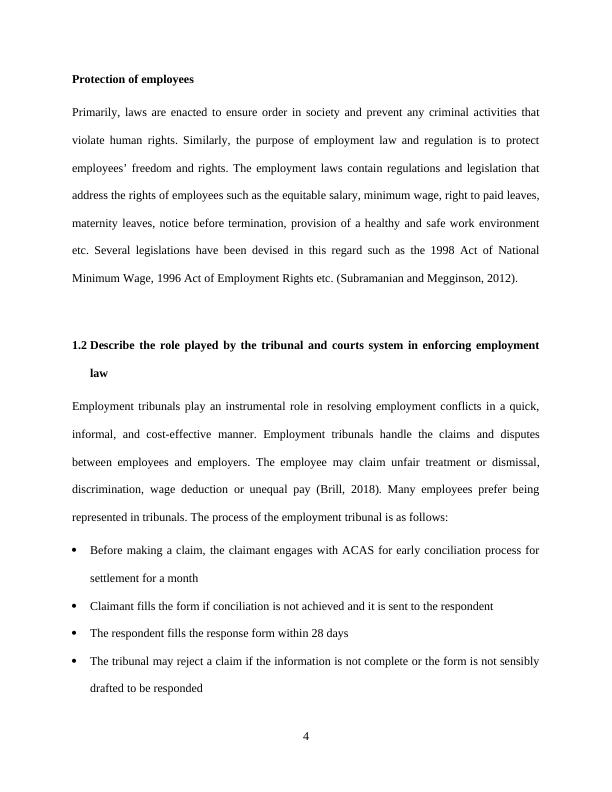
Case management order is issued if there are not issues
Preliminary hearings take place
Claimant prepares a schedule of losses
The relevant documents are disclosed
Written witness statements are prepared
The final hearing takes place chaired by the judge followed by a judgment
If the claimant or other party is unsatisfied, they can appeal to the tribunal
Either party can appeal for a retrial or reconsideration to the tribunal if they are unsatisfied
(Sourdin, 2016). The tribunal is responsible for decisions and managing appeals in case an error
has occurred due to any of the following reasons:
The decision is discriminatory to one party
The law is not implemented properly
The law is not acquired correctly
The evidence is not sufficient or available to support decision
The process has not been properly complied with
As a result, the court of appeal overrules all the other courts. The purpose of this court is to
handle appeals by reconsidering and rehearing the appeal. However, the court judges the case
based on the report of the trial and the judges’ notes. In case, the party is unsatisfied with the
court of appeal’s decision, the decision is taken to the Supreme Court (Subramanian and
Megginson, 2012). The decision of the Supreme Court (SC) is the final decision on the case.
The SC is the final court and plays an important role in ensuring compliance with employment
regulations. However, SC only reviews a case after it has been sufficiently conducted in minor
court. The case is heard from the court of appeal for a final decision (Sourdin, 2016).
5
Preliminary hearings take place
Claimant prepares a schedule of losses
The relevant documents are disclosed
Written witness statements are prepared
The final hearing takes place chaired by the judge followed by a judgment
If the claimant or other party is unsatisfied, they can appeal to the tribunal
Either party can appeal for a retrial or reconsideration to the tribunal if they are unsatisfied
(Sourdin, 2016). The tribunal is responsible for decisions and managing appeals in case an error
has occurred due to any of the following reasons:
The decision is discriminatory to one party
The law is not implemented properly
The law is not acquired correctly
The evidence is not sufficient or available to support decision
The process has not been properly complied with
As a result, the court of appeal overrules all the other courts. The purpose of this court is to
handle appeals by reconsidering and rehearing the appeal. However, the court judges the case
based on the report of the trial and the judges’ notes. In case, the party is unsatisfied with the
court of appeal’s decision, the decision is taken to the Supreme Court (Subramanian and
Megginson, 2012). The decision of the Supreme Court (SC) is the final decision on the case.
The SC is the final court and plays an important role in ensuring compliance with employment
regulations. However, SC only reviews a case after it has been sufficiently conducted in minor
court. The case is heard from the court of appeal for a final decision (Sourdin, 2016).
5
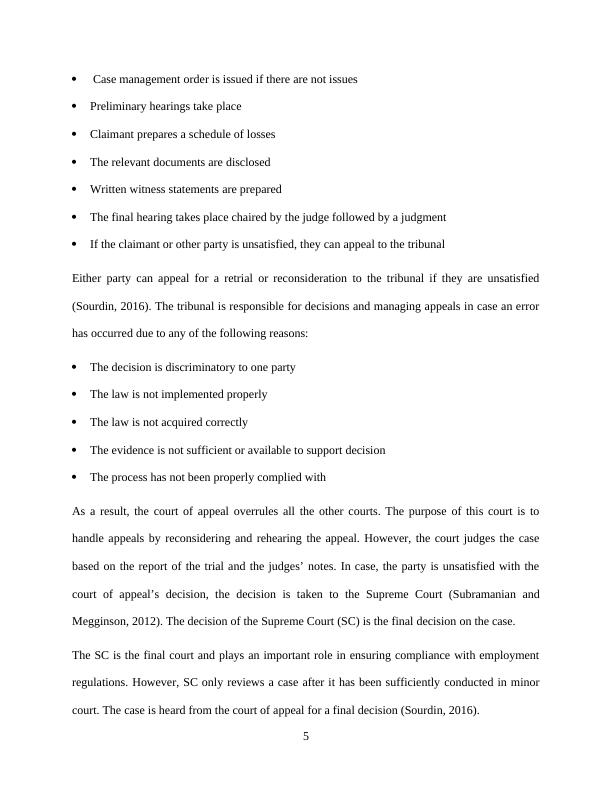
End of preview
Want to access all the pages? Upload your documents or become a member.
Related Documents
5EML- Employment Law Assignmentlg...
|20
|5496
|2223
Employment Law: Objective, Role of Employment Tribunal, Procedure, Discrimination Law, Employment Contracts, Alterations, Redundancy Law, Business Transferlg...
|20
|4559
|91
Employment Law: A Comprehensive Guidelg...
|20
|6701
|71
Employment Law Analysis for National Bank Dubai Saudi Arabian Branchlg...
|23
|5816
|90
Employment Law: A Comprehensive Guidelg...
|17
|6813
|56
Employment Law: Rights, Regulations, and Disputeslg...
|17
|5430
|3
